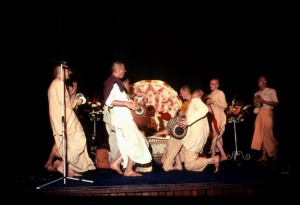CC Madhya 6.152: Difference between revisions
m (1 revision(s)) |
(Vanibot #0054 edit - transform synonyms into clickable links, which search similar occurrences) |
||
| (One intermediate revision by one other user not shown) | |||
| Line 1: | Line 1: | ||
{{ | [[Category:Sri Caitanya-caritamrta - Madhya-lila Chapter 06|C152]] | ||
<div style="float:left">'''[[Sri Caitanya-caritamrta|Śrī Caitanya-caritāmṛta]] - [[CC Madhya|Madhya-līlā]] - [[CC Madhya 6|Chapter 6: The Liberation of Sārvabhauma Bhaṭṭācārya]]'''</div> | |||
<div style="float:right">[[File:Go-previous.png|link=CC Madhya 6.151|Madhya-līlā 6.151]] '''[[CC Madhya 6.151|Madhya-līlā 6.151]] - [[CC Madhya 6.153|Madhya-līlā 6.153]]''' [[File:Go-next.png|link=CC Madhya 6.153|Madhya-līlā 6.153]]</div> | |||
{{CompareVersions|CC|Madhya 6.152|CC 1975|CC 1996}} | |||
{{RandomImage}} | |||
==== TEXT 152 ==== | ==== TEXT 152 ==== | ||
<div | <div class="verse"> | ||
ṣaḍ-aiśvarya-pūrṇānanda-vigraha yāṅhāra | :ṣaḍ-aiśvarya-pūrṇānanda-vigraha yāṅhāra | ||
hena-bhagavāne tumi kaha nirākāra? | :hena-bhagavāne tumi kaha nirākāra? | ||
</div> | </div> | ||
| Line 12: | Line 16: | ||
==== SYNONYMS ==== | ==== SYNONYMS ==== | ||
<div | <div class="synonyms"> | ||
ṣaṭ-aiśvarya- | ''[//vanipedia.org/wiki/Special:VaniSearch?s=ṣaṭ&tab=syno_o&ds=1 ṣaṭ]-[//vanipedia.org/wiki/Special:VaniSearch?s=aiśvarya&tab=syno_o&ds=1 aiśvarya]-[//vanipedia.org/wiki/Special:VaniSearch?s=pūrṇa&tab=syno_o&ds=1 pūrṇa]'' — with six opulences in full; ''[//vanipedia.org/wiki/Special:VaniSearch?s=ānanda&tab=syno_o&ds=1 ānanda]'' — blissful; ''[//vanipedia.org/wiki/Special:VaniSearch?s=vigraha&tab=syno_o&ds=1 vigraha]'' — form; ''[//vanipedia.org/wiki/Special:VaniSearch?s=yāṅhāra&tab=syno_o&ds=1 yāṅhāra]'' — whose; ''[//vanipedia.org/wiki/Special:VaniSearch?s=hena&tab=syno_o&ds=1 hena]-[//vanipedia.org/wiki/Special:VaniSearch?s=bhagavāne&tab=syno_o&ds=1 bhagavāne]'' — unto that Supreme Personality of Godhead; ''[//vanipedia.org/wiki/Special:VaniSearch?s=tumi&tab=syno_o&ds=1 tumi]'' — you; ''[//vanipedia.org/wiki/Special:VaniSearch?s=kaha&tab=syno_o&ds=1 kaha]'' — said; ''[//vanipedia.org/wiki/Special:VaniSearch?s=nirākāra&tab=syno_o&ds=1 nirākāra]'' — without any form. | ||
</div> | </div> | ||
| Line 19: | Line 23: | ||
==== TRANSLATION ==== | ==== TRANSLATION ==== | ||
<div | <div class="translation"> | ||
“Are you describing as formless that Supreme Personality of Godhead whose transcendental form is complete with six transcendental opulences? | “Are you describing as formless that Supreme Personality of Godhead whose transcendental form is complete with six transcendental opulences? | ||
</div> | </div> | ||
| Line 26: | Line 30: | ||
==== PURPORT ==== | ==== PURPORT ==== | ||
<div | <div class="purport"> | ||
If the Supreme Personality of Godhead is formless, how can He be said to walk very fast and accept everything offered to Him? Rejecting the direct meaning of the Vedic mantras, the Māyāvādī philosophers interpret them and try to establish the Absolute Truth as formless. Actually, the Supreme Lord has an eternal personal form full of all opulence. The Māyāvādī philosophers try to interpret the Absolute Truth as being without potency. However, in the Śvetāśvatara Upaniṣad (6.8) it is clearly said, parāsya śaktir vividhaiva śrūyate: [ | If the Supreme Personality of Godhead is formless, how can He be said to walk very fast and accept everything offered to Him? Rejecting the direct meaning of the Vedic ''mantras'', the Māyāvādī philosophers interpret them and try to establish the Absolute Truth as formless. Actually, the Supreme Lord has an eternal personal form full of all opulence. The Māyāvādī philosophers try to interpret the Absolute Truth as being without potency. However, in the ''Śvetāśvatara Upaniṣad'' (6.8) it is clearly said, ''parāsya śaktir vividhaiva śrūyate:'' ([[CC Madhya 13.65|CC Madhya 13.65, purport]]) “The Absolute Truth has multipotencies.” | ||
</div> | </div> | ||
__NOTOC__ | |||
<div style="float:right; clear:both;">[[File:Go-previous.png|link=CC Madhya 6.151|Madhya-līlā 6.151]] '''[[CC Madhya 6.151|Madhya-līlā 6.151]] - [[CC Madhya 6.153|Madhya-līlā 6.153]]''' [[File:Go-next.png|link=CC Madhya 6.153|Madhya-līlā 6.153]]</div> | |||
__NOTOC__ | |||
__NOEDITSECTION__ | |||
Latest revision as of 23:40, 19 February 2024

A.C. Bhaktivedanta Swami Prabhupada
TEXT 152
- ṣaḍ-aiśvarya-pūrṇānanda-vigraha yāṅhāra
- hena-bhagavāne tumi kaha nirākāra?
SYNONYMS
ṣaṭ-aiśvarya-pūrṇa — with six opulences in full; ānanda — blissful; vigraha — form; yāṅhāra — whose; hena-bhagavāne — unto that Supreme Personality of Godhead; tumi — you; kaha — said; nirākāra — without any form.
TRANSLATION
“Are you describing as formless that Supreme Personality of Godhead whose transcendental form is complete with six transcendental opulences?
PURPORT
If the Supreme Personality of Godhead is formless, how can He be said to walk very fast and accept everything offered to Him? Rejecting the direct meaning of the Vedic mantras, the Māyāvādī philosophers interpret them and try to establish the Absolute Truth as formless. Actually, the Supreme Lord has an eternal personal form full of all opulence. The Māyāvādī philosophers try to interpret the Absolute Truth as being without potency. However, in the Śvetāśvatara Upaniṣad (6.8) it is clearly said, parāsya śaktir vividhaiva śrūyate: (CC Madhya 13.65, purport) “The Absolute Truth has multipotencies.”